The sheer number of habitat-restricted specials found in northern Argentina was the main reason why my two friends, Garret and Daniel, and I decided to plan a birding trip to this seemingly underrated part of the country. Being my first trip to the Neotropics, I was not fussy about where that trip would be; however, in retrospect, I am so glad it was this one! This northwestern Argentina birding trip would soon become the best birding trip I’ve done up to now!
We arrived in Buenos Aires late in the evening and spent the night in a hotel in town. The following morning, we were fetched from the hotel by our guide for the day, Francisco, who took us out for a day of birding north of the city. We enjoyed the many Rufous-collared Sparrows, Crested and Chimango Caracaras, Southern Lapwings, Rufous Horneros (Argentina’s national bird), Chalk-browed Mockingbirds, Monk Parakeets, Eared Doves and Picazuro Pigeons along the way as we ventured out of the city and to the wetlands of the great Paraña River. This was one of the most unforgettable birding days I’ve ever experienced, as out of the 132 species seen on the day, 120 were lifers for me! Some of the regional specials we saw around the river were Spix’s Spinetail, Diademed Tanager, Warbling Doradito, Black-and-rufous Warbling Finch, Grey-throated Warbling Finch, Brown-and-yellow Marshbird, Gilded Sapphire (my first hummingbird!), Unicolored Blackbird, the vivid Scarlet-headed Blackbird, Freckle-breasted Thornbird, and raucous Dusky-legged Guans.

We managed to find three individuals of the scarce Warbling Doradito in the Paraña wetlands.
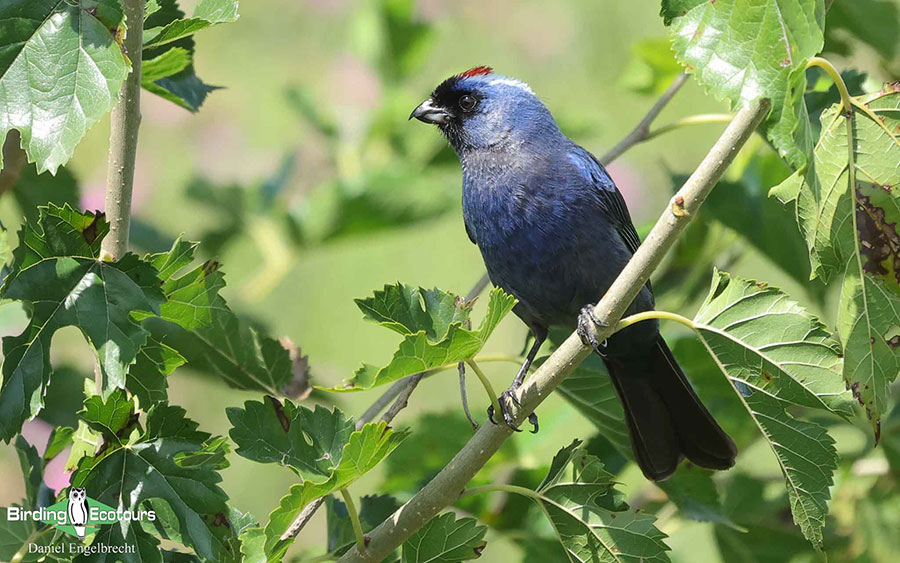
The beautiful Diademed Tanager was one of a handful of Atlantic Forest endemics we saw near Buenos Aires.
One of our main objectives while birding these wetlands was to find the three reedhaunter species, all of which are only found in swampy habitats of Uruguay, southern Brazil and eastern Argentina. Fortunately, Francisco had spots for all three of them, all of which proved fruitful. Sulphur-bearded Reedhaunter was first, followed by the larger Curve-billed Reedhaunter. Straight-billed Reedhaunter (the most range-restricted one) took a bit more time and persistence to find, but eventually, we were treated to stunning visuals of this strange furnarid sitting on a Serrucheta plant; an important component of this bird’s habitat.
Other highlights from this area included Rufous-capped Antshrike, Bluish-grey Saltator, Spectacled Tyrant, close views of Sooty Tyrannulet,many duck species including Yellow-billed Teal, Yellow-billed Pintail, Ringed Teal, Silver Teal, Rosy-billed Pochard, and Brazilian Teal, massive Southern Screamers, beautiful Whistling Herons, good numbers of Giant Wood Rails and Snail Kites, a flyby from a Rufous-thighed Hawk, a surprising Black-collared Hawk (rare in Buenos Aires), four cuckoo species (Dark-billed, Striped, Ash-colored and the sociable Guira Cuckoo), and brilliant views of a pair of Rufous-sided Crakes.
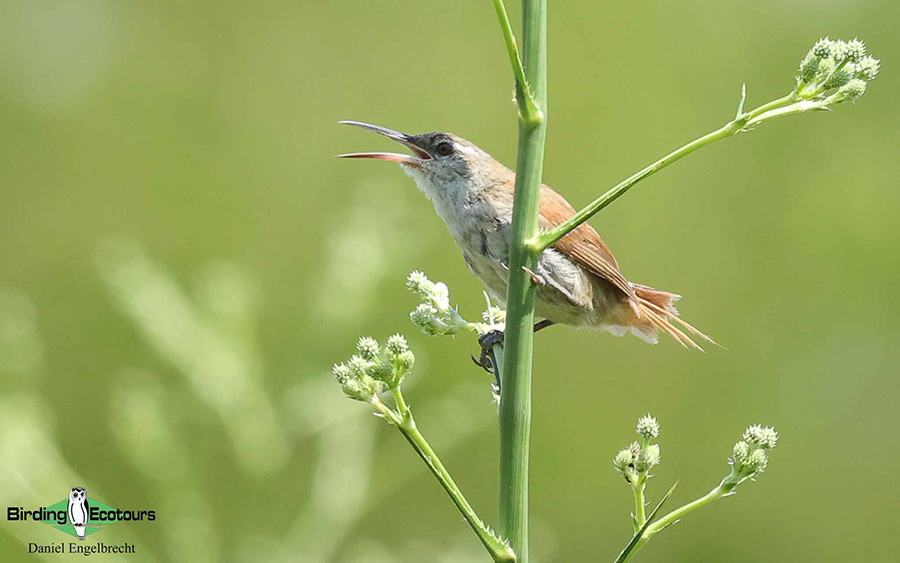
The Straight-billed Reedhaunter was our most range-restricted target species for the first day of the trip.
After we’d had our fill in the wetlands, we journeyed north of the Paraña River into the subtropical Espinal woodlands east of Ceibas. The low Acacia scrub and sandy flats here are very reminiscent of southern African savannah, and played host to a variety of bush species, many of which we would see again later on. These included White-tipped Plantcutter, White-crested Tyrannulet, Stripe-crowned Spinetail, Narrow-billed Woodcreeper, Lark-like Brushrunner, Black-capped Warbling Finch, Brown Cacholote, Golden-billed Saltator, Checkered Woodpecker, Scimitar-billed Woodcreeper, Tufted Tit-Spinetail, Red-crested Cardinal, Greyish Baywing, Masked Gnatcatcher, groups of charming White-fronted Woodpeckers and bulky Spot-winged Pigeons (which replace the Picazuro Pigeons in drier areas). We also got our only views of Little Thornbird, Chotoy Spinetail and Short-billed Canastero for the trip along this road.
We made a stop near some large eucalyptus trees that were adorned with the dense communal nests of Monk Parakeets.This spot also yielded a pair of stunning White Woodpeckers gathering food for their chicks and a vocal family of Savanna Hawks. Other highlights from the woodlands included two more Ash-colored Cuckoos and a single Variable Oriole.
The few wetlands along the road also delivered good species, namely Long-tailed Reed Finch, striking White-browed Meadowlarks and two more Warbling Doraditos. Our last stop of the day produced White-naped Xenopsaris, Yellow-browed Tyrant and our first White Monjita, as well as Maguari Stork, Fulvous Whistling Duck and White-winged Coot on a nearby water body.
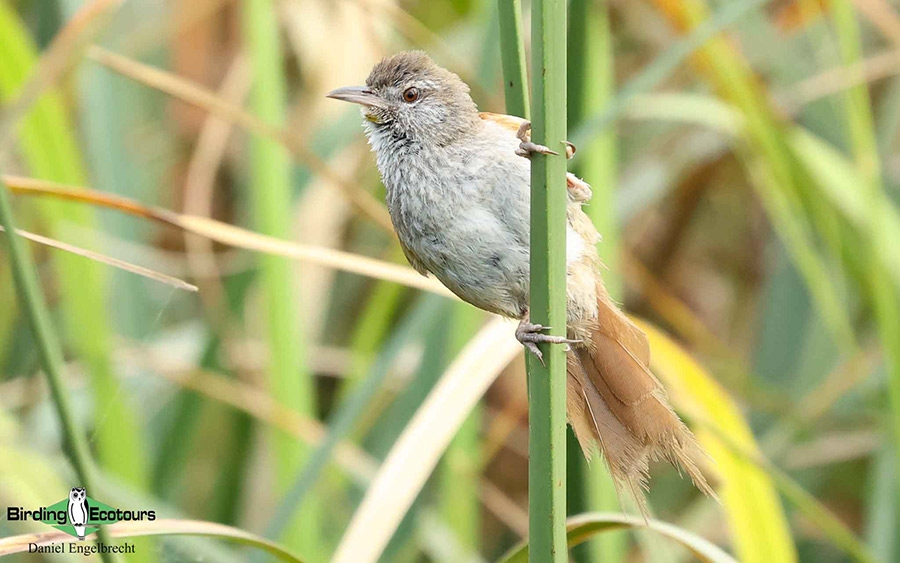
The first Reedhaunter we saw was Sulphur-bearded Reedhaunter, which showed exceptionally well.
As a newcomer to South America, I also greatly enjoyed getting to grips with some of the more common or widespread neotropical species seen throughout the day, including Black Vulture, Green-barred Woodpecker, House Wren, Cattle Tyrant, Great Kiskadee, Burrowing Owl, Fork-tailed Flycatcher, Tropical Kingbird, Southern Streaked Flycatcher, Southern Beardless-Tyrannulet, Pampa Finch, Glittering-bellied Emerald, White-faced and Bare-faced Ibis, Wattled Jacana, Ringed Kingfisher, Collared Plover, Creamy-bellied and Rufous-bellied Thrush, Blue-and-white Swallow, Grey-breasted and Brown-chested Martin, Southern Yellowthroat, Scarlet Flycatcher, Sayaca Tanager, Small-billed Elaenia, Saffron Finch, Grassland Yellow Finch and Double-collared Seedeater. As we came back into Buenos Aires after a phenomenal first day, our last bird of the day became a Harris’s Hawk sitting on a street light.
We flew early the next morning up to Cordoba, where we met our guide, Martin Toledo, and headed west. We stopped at a gas station where the surrounding disturbed woodland-farmland gave us our first views of Black-and-chestnut Warbling Finch and Southern Martin. We continued west towards the dramatic Sierras de Cordoba, a mountain range located in the Cordoba province that is not attached to the Andes. The mountains are sandwiched between the wetter Espinal woodland to the east and the Dry Chaco woodland to the west, with the mountains themselves being more temperate. Driving through the Espinal woodland on the eastern foothills (locally called Sierran Chaco), we made a stop along this spectacular pass, which delivered the lovely Olive-crowned Crescentchest and our first Blue-and-yellow Tanager and Chiguanco Thrush (the Argentine subspecies is sometimes split as Sombre Thrush).

The normally secretive Olive-crowned Crescentchest put on quite a show for us.
Continuing up the pass, rolling grassy slopes and rocky outcrops started to replace the Acacia woodland and with the change came new birds like Buff-necked Ibis, Grass Wren, Hellmayr’s Pipit, soaring Turkey Vultures, a single Andean Tinamou flushed from the roadside and Long-tailed Meadowlark (the subspecies here is endemic to these mountains and is a proposed split). Higher up the pass, the rocky nature of the Sierras became clear, and the birding took on a slightly Andean flavor. Species like Ash-breasted and Plumbeous Sierra Finch, Band-tailed Seedeater, Black-billed Shrike-Tyrant, Puna Canastero, Brown-capped Tit-Spinetail, Tufted Tit-Tyrant, Andean Swift, Variable Hawk, Black-chested Buzzard-Eagle and the grand Andean Condor were in evidence in these higher reaches of the mountains. This was also where the sparkling Red-tailed Comet revealed itself; a truly spectacular hummingbird with a limited range, only being found in mountainous regions between southern Bolivia and northern Argentina.
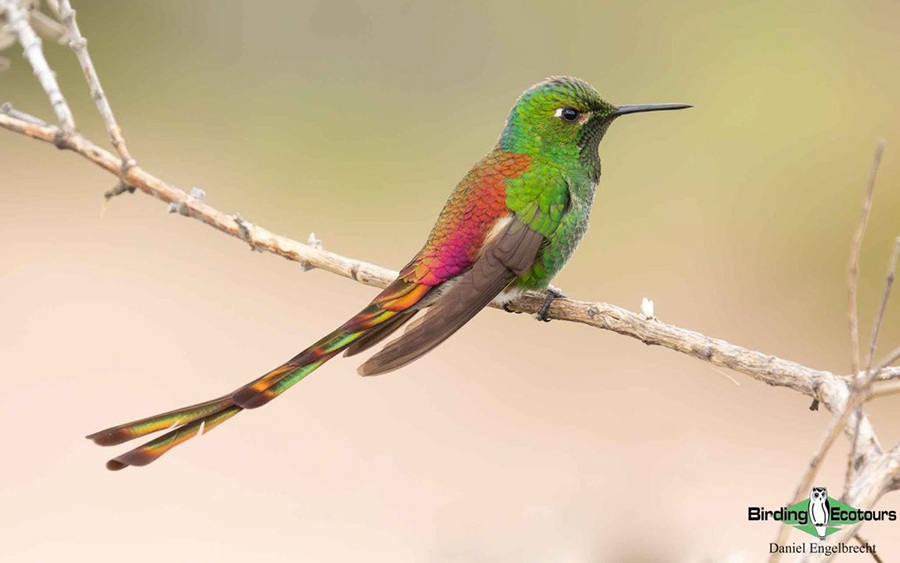
One of the highlights of our first day in Cordoba was this splendid Red-tailed Comet perched near the roadside.
At these altitudes, the grasslands had diminished and were replaced by smaller patches of boggy moorland. This was the preferred habitat of the endemic Cordoba Cinclodes, and we managed to connect with a few of these rufous-winged furnarids during our time in the high Sierras. Just before reaching our lunch stop at the appropriately named El Condor restaurant, we connected with the larger White-winged Cinclodes.Upon arriving in the restaurant parking lot, we were treated to our third cinclodes species of the day: Olrog’s Cinclodes. Like Cordoba Cinclodes, this species is endemic to the Cordoba Sierras and was a major target for us, so to get one waltzing around a parking lot next to a busy road was incredible!After wolfing down some milanesas for lunch, we were back on the road, now heading down the western side of the mountains. Investigating a small roadside wetland got us Plumbeous Rail, Neotropic Cormorant and two more Olrog’s Cinclodes, while a grassland patch lower down the mountain saw us flush the rare Darwin’s Nothura.
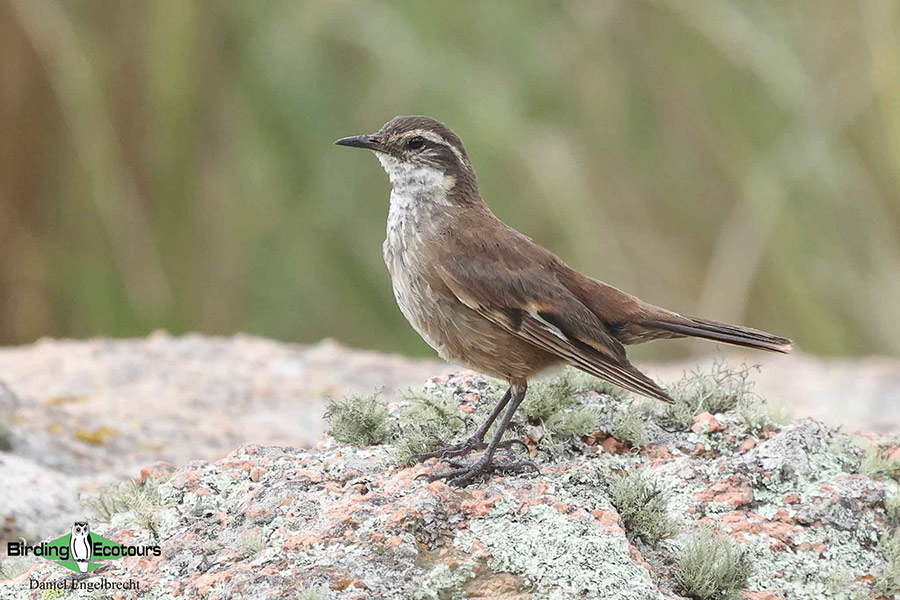
The third cinclodes species for the day and second Argentine endemic for the trip: Olrog’s Cinclodes.
We then descended all the way down the mountain and entered the Dry Chaco, a taller and drier type of woodland than the Espinal. Once again, a variety of new birds suddenly became available to us upon entering this unique habitat. The woodlands east of the town of Nono were particularly productive, and we spent over an hour here connecting with many of our trip targets. The stars of the show had to be a pair of Black-legged Seriemas duetting a few meters from the roadside, although it did take them a while to show themselves. The supporting cast was made up of many birds we had seen in the Espinal near Ceibas, but included Chaco Puffbird, Greater Wagtail-Tyrant, Crowned Slaty Flycatcher,flocks of Blue-crowned Parakeets and a stunning female Cream-backed Woodpecker. We also made two stops in the woodlands near Mina Clavero. One delivered the rare Black-bodied Woodpecker, along with Crested Hornero and Fulvous-crowned Scrub Tyrant, while the other gave us views of Chaco Earthcreeper and Ringed Warbling Finch.
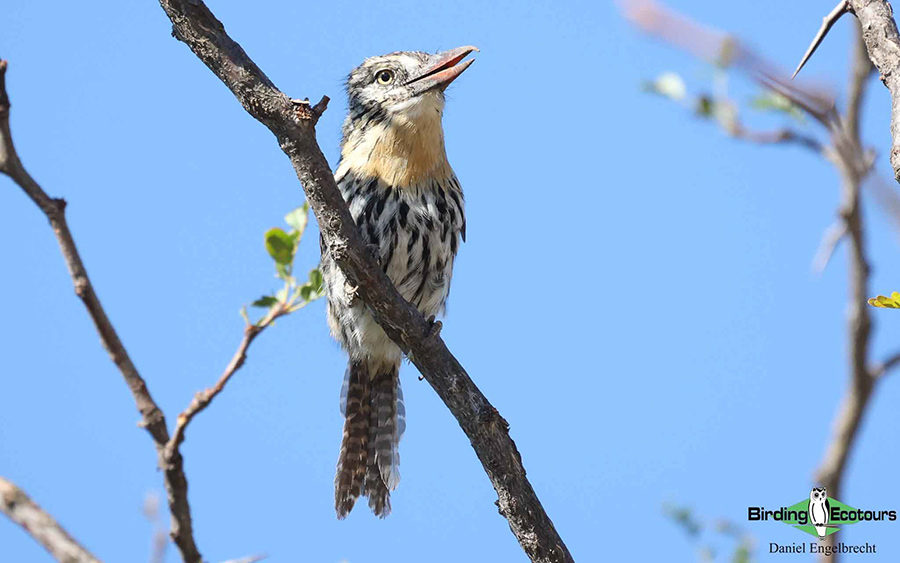
We were serenaded by the mournful whistles of Chaco Puffbirds while near Nono.
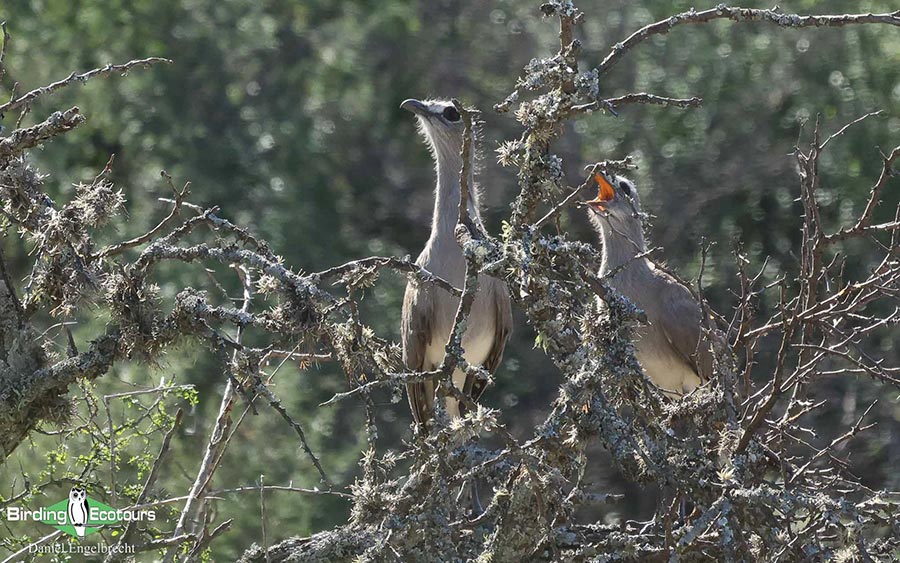
Unlike its more widespread, red-legged cousin, the Black-legged Seriema is restricted to the Chaco.
After some great Chaco birding, we did the long drive north through the farmlands towards our accommodation near Villa Viso, with an impromptu roadside stop for a Spotted Nothura running through the fallow fields. We then turned in for a delicious asado at Martin’s grandmother’s farm, our base for the next two days.
The following morning, we were treated to a pair of Campo Flickers feeding with a pair of Green-backed Woodpeckers as we left our accommodation. Martin took us to a large wetland situated amidst the farmlands nearby, where we added the tiny Bay-capped Wren-Spinetail (the smallest furnarid of the trip), Red Shoveler and the elegant Long-winged Harrier to our ever-growing trip list. The surrounding farmlands and fragmented scrub delivered Grassland Sparrow, Brushland Tinamou on the roadside and a delightful group of Firewood-gatherers (surely one of the most uniquely-named birds). There were also plenty of swallows flying around the wetland, and these included White-rumped Swallows, Sand Martins and Tawny-headed Swallows. Birding the riverine woodlands around Salsacate got us great views of Brown-capped Whitestart, Grey-cowled Wood Rail and Ultramarine Grosbeak.
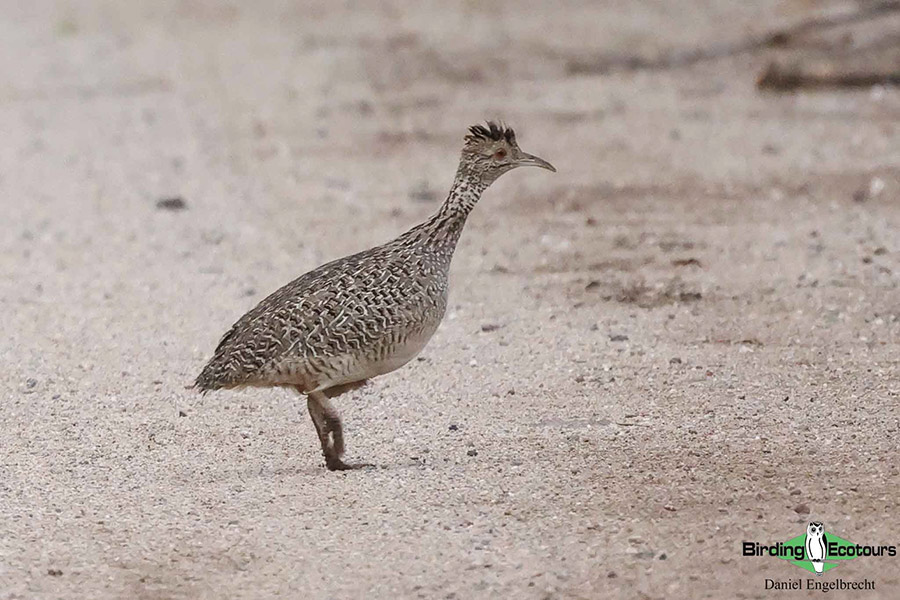
We had several showy Brushland Tinamous throughout the trip, rather atypical tinamou behavior!
Post-siesta, we went out for a late afternoon mission to Chancani National Park, descending the breathtaking Mirador Chancani Pass. As well as the views, the pass provided us with close-up looks of the dainty Grey-hooded Parakeet.Once we arrived at the gate to Chancani, we parked and walked into the pristine, mature, Dry Chaco that seemed to extend for miles around us. We were once again treated to a plethora of Chaco birds that included Many-colored Chaco Finch, Red-crested Finch, Cinereous Tyrant, Straneck’s Tyrannulet, Southern Scrub Flycatcher, Suiriri Flycatcher,and the strange Crested Gallito. We waited here until night time when we attempted to find Chaco Owl, to no avail. However, we still found a few night birds: Tropical Screech Owl, Ferruginous Pygmy Owl and a stunning male Scissor-tailed Nightjar made up the nocturnal roster.
After bidding both Cordoba and Martin a farewell, we started on the long journey north towards the Andes, stopping en route at Dean Funes and birding the Salinas Grandes, two huge salt pans north of the town. These pans hold almost the entire world population of the Salinas Monjita, a brown and white, chat-like tyrant with a very specific niche. Only found in the sparse vegetation around the edges of these few pans, this bird is a true habitat specialist. We were fortunate enough to locate a pair with a fledgling without much difficulty. The Chaco surrounding the Salinas was very productive too, and here we added Little Nightjar (as we arrived before dawn)and the bulky Elegant Crested Tinamou
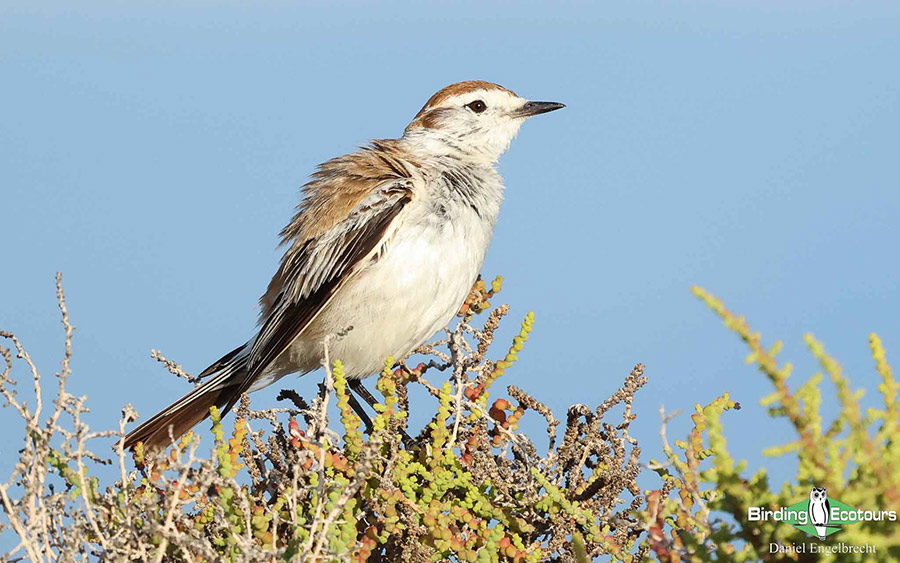
Finding a family of the specialized Salinas Monjita was one of the highlights of the whole trip.
From this point on, we journeyed into the Andes, where a bounty of special birds awaited us. You can read all about this next part of our adventure in part two of this blog.
Ready to experience the wild diversity of Argentina for yourself?
With over 1,064 bird species, including 16 endemics, Argentina is not to be overlooked among the more well-known Neotropical birding destinations. Our tours focus on tracking down the region’s most sought-after species — with expert local guides who know the birds best.
Some of the standout species that can be seen on our Northwest Argentina tour include:
Rufous-throated Dipper, Diademed Sandpiper-Plover, Sandy Gallito, Red-faced Guan, Tucuman Mountain Finch, Moreno’s Ground Dove, Red-tailed Comet, Wedge-tailed Hillstar,the attractive Burrowing Parrot, White-throated Antpitta, Tucuman Amazon, Lyre-tailed Nightjar, Giant Antshrike, Black-legged Seriema and Black-bodied Woodpecker.
Browse all our Argentina birding tours here:
https://www.birdingecotours.com/destination/argentina-birding-tours/
Or email us at [email protected] and let us help you plan the perfect trip.
